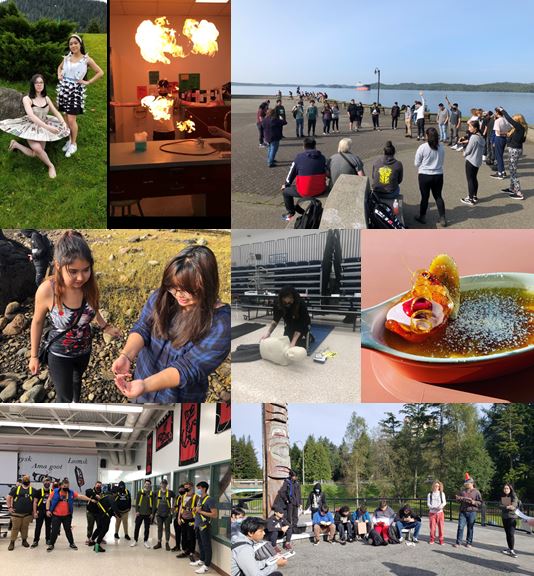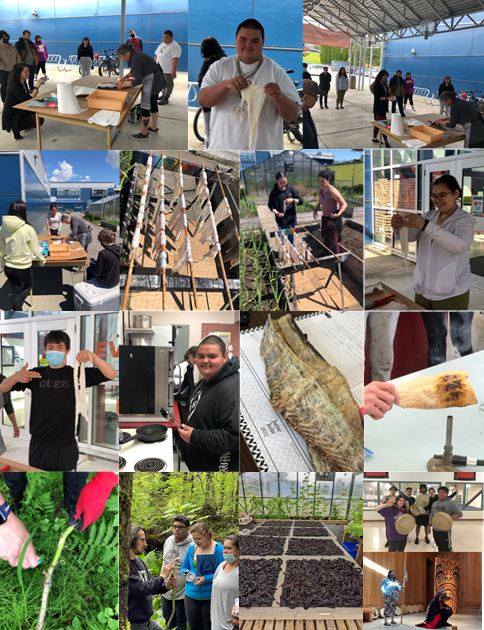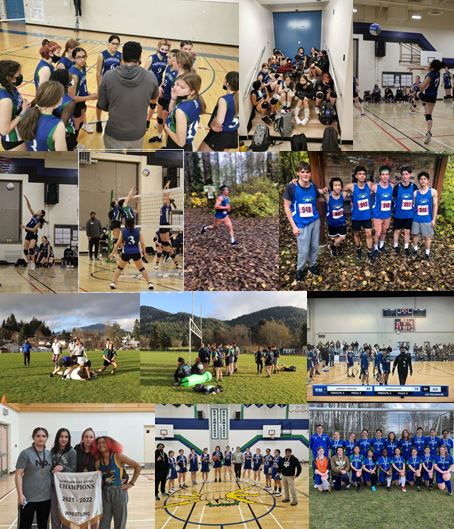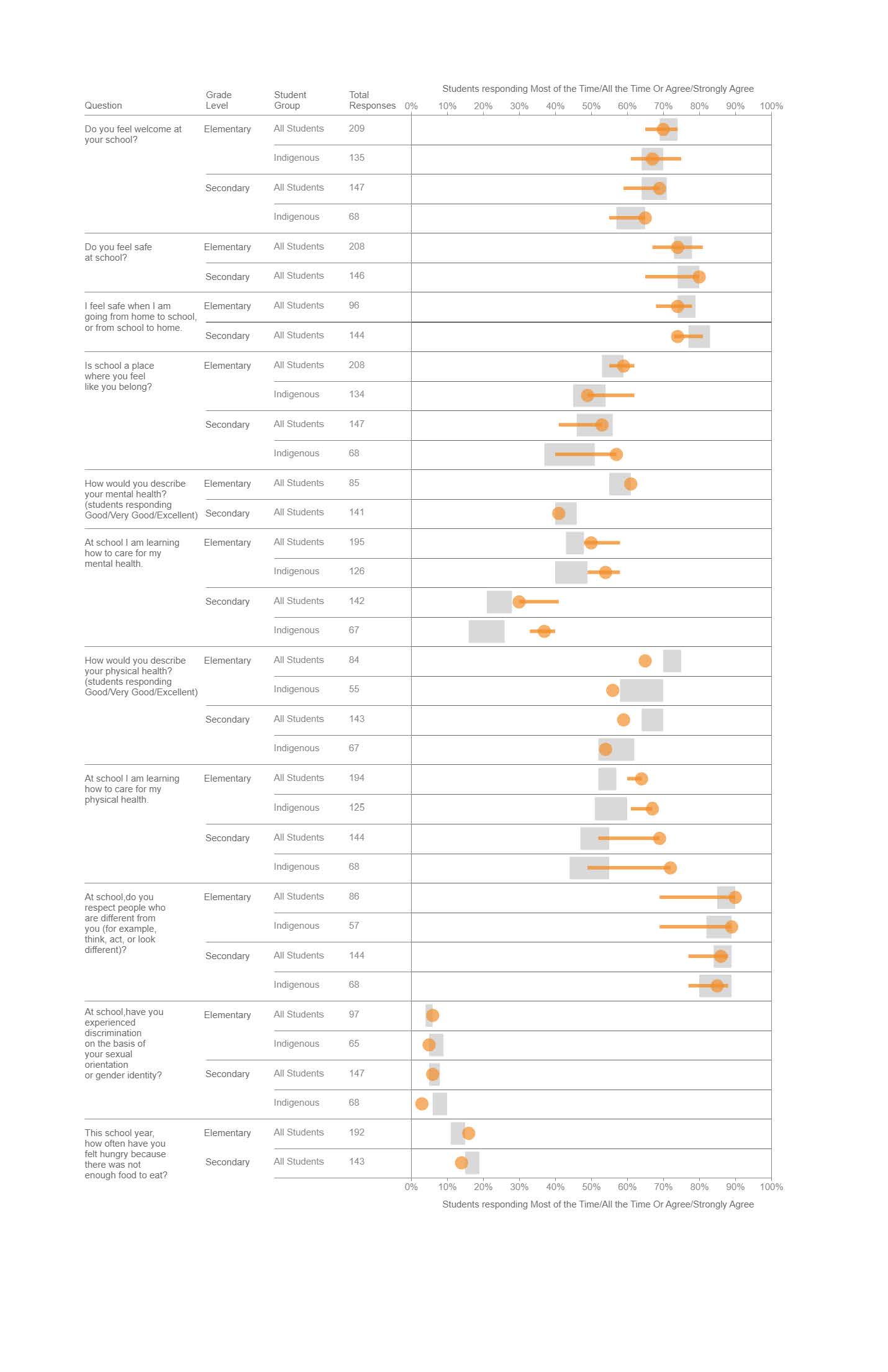![]() Charles Hays Secondary Updated 2023
Charles Hays Secondary Updated 2023
What are the unique, positive characteristics of our school?
CHSS is a dual-track school with a French Immersion Program and offers Sm’algyax and French as second language courses. The school has a strong academic program, a trades program, a highly competitive sports program, and a vibrant fine arts program.
In 2021/22, we implemented a two classes per day, four terms per year quarter system. For the upcoming 2023/24 school year we will be moving to a Semester System with double blocks. The semester system is four classes per day from September to January, then a new four classes from January to June. The double blocks on Tuesdays and Thursdays will allow students and teachers to engage in the deeper learning, discussion, outdoor learning, and hands-on learning that we have enjoyed with the quarter system. We have heard positive feedback from students, community supports, and staff that not having bells has reduced anxiety for some students. This has positively impacted students with auditory sensitivity so for next year we will start with no bells and assess throughout the year.
Our staff consists of Teachers, Education Assistants, Secretaries, Counsellors, Fluent Language Speakers/Elders, Indigenous Family Resource Workers, a District Careers Teacher, an Equity Mentor, and an Indigenous Coach Mentor. A new position next year will be a Food Sovereignty Mentor which is a role funded through a grant partnership.
What are the important demographics of our school and community?
Charles Hays Secondary School (CHSS) is a grade 9 – 12 high school located in the City of Prince Rupert on the unceded territory of the Ts’msyen and Sm’algyax language speaking peoples, who have been stewards of this land since time immemorial. The school has a diverse multicultural population including 55% students of Indigenous ancestry. Our enrollment is up slightly and was approximately 595 students in September 2022 and we are forecasted for 622 in September 2023.
We are steps away from nature and in our backyard are outdoor learning opportunities that include learning about the local flora and fauna, the history of the territory taught by Indigenous Elders, and experiencing the beauty of Prince Rupert.
We have students with diverse needs and are thankful for the Community Links and Breakfast Club of Canada funding for our Breakfast Club and Lunch Program.
The majority of CHSS students live in Prince Rupert, we also have students arrive from Metlakatla by ferry and bus and from the village of Port Edward by bus every day.
What do we celebrate?
We have a great deal to celebrate at CHSS including:
- Culturally and socially aware staff and students,
- Sm'algyax language and artwork are incorporated into the school and classrooms.
- Strong community partnerships,
- Thriving Sports programs (Basketball, Volleyball, Track, Soccer, Rugby, Wrestling),
- Exceptional Arts programs (Band, Drama, Musical, Visual Arts)
- A new Library Learning Commons,
- A dynamic greenhouse that produces Farm to Table produce for our Foods Program,
- A delicious Foods Program,
- Sm'algyax and French classes from grades 9-12,
- Transitions Feast to welcome the new grade 8 students to CHSS,
- Excellent shop facilities,
- Basketball Academy,
- Hockey Academy,
- Clubs- Art, Chess, E-Sports, and Book Club,
- Student Council,
- Rotary Interact Club,
- French Immersion,
- PRIDE,
- Youth Explore Trades Sampler and Youth Work in Trades,
- Specialized Science Course
- Math Contest Participation,
- Place-Based Learning,
- Family Bingo Nights,
Relationships and connection.
What are the strengths and stretches we see in our learners?
Strengths:
- Community oriented,
- Inclusive,
- Respectful,
- Culturally aware,
- Have a strong sense of belonging,
- Socially & emotionally aware,
Stretches:
- COVID-19 Learning Loss,
- Social Emotional Resilience,
- Communication,
- Environmental awareness,
- Striving to improve Literacy and Numeracy,
- Attendance and preparedness,
- Apathy,
- Numeracy/Literacy
What evidence do we have of these strengths and stretches?
Strengths:
- CHSS students are involved in service clubs such as Student Council and Interact. They embrace local cultural events (Orange Shirt Day, Moose Hide Day, Red Dress Day to name a few), donate to charities, do a lot of fundraising, and volunteer for the community.
- Diversity in the school is evidenced by a vibrant and well attended PRIDE celebration, the inclusion of pronouns in classroom activities and e-mails, Wellness Wednesday participation, and inclusivity in classrooms.
- Participation of students in the Student Voice Advisory Group on Anti-Racism, as well as visuals around the school.
- The majority of classes involved in Truth and Reconciliation through in class learning, creating visuals for the hallway, and participating in the events throughout the year.
- Respectful and culturally aware is evidenced by the Luulgit Learning Feast (welcoming grade 8s to CHSS), Indigenous Day Celebrations, Honouring Indigenous Veterans, learning on the land and from Elders in collaboration with the Indigenous Education Department.
- Belonging is evidenced by our FESL data and student demeanor in our school.
- CHSS connections with Ministry of Child and Family Development Child and Youth Mental Health (CYMH), Public Health Nurses, and Victim Services to collaborate on supporting students in need.
- Connections with Learning Services to co-support students with diverse abilities and disabilities as well as outside organizations such as POPARD.
- School-based Truth and Reconciliation Committee.
Stretches:
- We can improve our understanding of environmental stewardship at CHSS by heightening our recycling, using less, composting, littering, and talking more about the environmental impact of climate change. A school-wide climate-change commitment should be created.
- Social-emotional learning specifically anxiety and stress are concerns for our students and a focus of the next school year's goals. Wellness Wednesday has been very helpful, but the commitment needs to continue with social-emotional lessons in all classes.
- Our Literacy assessment data indicates that our student's proficiency level is comparable with the provincial average. However, students have said that they enjoy reading less and this is a priority for next year. We will continue to host novel studies, and look at bringing in resources at every reading level.
- The Numeracy data indicates that we have more work to do in helping students understand how to apply their math skills to real world problems. Math classes have been doing word problems with their students at the beginning of the day, and moving into a semester system, students will have math for half a year.
What areas will we focus on to improve or enhance success for our learners based on what we know about them?
Our overarching goals are Equity, Inclusivity, Mental Health Literacy and Truth and Reconciliation. A primary goal of CHSS is to address systemic barriers impacting Indigenous student achievement. We also strive to ensure that education at CHSS inclusive and accessible to all students.
1) To use the First People's Principles of Learning to guide the education and operation of CHSS.
2) To improve literacy rates.
3) To enhance student application of numeracy.
4) To embed Social Emotional Learning into all interactions within the school community.
What are our specific goals?
EQUITY
Anti Racism Commitment
Charles Hays Secondary School is committed to creating a welcoming and equitable learning environment that is responsive and inclusive.
In January 2023, the B.C. government launched the provincial K-12 Anti-Racism Action Plan to support school districts in their commitment to anti-racism initiatives in their school communities. This plan is a multi-year framework to specifically address racism and discrimination in education and to create a culture and climate of belonging for all students, staff, and families. The Action Plan includes six priority areas of action: Community Voice, Removing Barriers, Raising Awareness, Collaborative Change, Capacity Building, and School Support.
The K-12 Anti-Racism Action Plan is designed to improve outcomes for Indigenous, Black, and People of Colour and support sector-wide understanding and growth of anti-oppressive systemic practices and content. The Action Plan provides supports and builds equity-based initiatives to start to address historical and oppressive barriers and lead to student success and ultimately empower students and educators to respond to discrimination.
Our commitment at CHSS is to enact this plan through:
1. Furthering our learning about systemic racism and what it means to be Anti-Racist
2. Update our Code of Conduct to reflect the Action Plan
3. Understanding our shared responsibility in dismantling racism through tough conversations and adopting new approaches.
Truth and Reconciliation
Staff Commitment to Truth and Reconciliation:
Our staff commitment to Truth and Reconciliation is built on Relationships, Capacity and łoomsk (respect the land, respect yourself and respect others).
· Relationships involve: Social/Emotional Learning; Trauma Informed Practice; Identity; relationships to others and self (bias and privilege)
· Capacity involves: professional learning with students and staff; sharing, collaboration; reflection and change; true history today; support; assessment; and pedagogy.
· łoomsk involves: rights holders, cultural connections; recognizing Indigenous knowledge in a variety of ways; the importance of language (the language of the territory Sm'algyax and recognizing problematic colonial language)
Our Goals:
1. Sharing and reviewing Indigenous student data including the Annual District Growth Plan Report and the How Are We Doing Aboriginal Report to make evidence-based decisions regarding school growth. School growth action items will include:
· Incorporate Sm’algyax into day-to-day greetings, emails, classroom routines, and announcements.
· Increase and maintain local Indigenous imagery and art on display throughout the school. Including increased bulletin board space to replace the locker displays.
· Celebrate Indigenous culture by recognizing relevant days throughout the school year. Including the annual Red Dress Walk and honouring National Indigenous Peoples Day (including student presenters if possible) and National Indigenous History Month.
· Increased opportunities for drumming, and to grow a drumming program connected to our school.
· Increasing Indigenous student participation in school clubs, teams and student council.
· Celebrating our students with slide shows on the school televisions.
2. Consultation with Indigenous members connected to our school community to:
· Update code of conduct to include culturally appropriate restorative practice.
· Increase participation of Indigenous Families in CHSS Parent Advisory Committee.
Literacy
· Our school wide goal is to focus on Literacy in each and every class. Each Department is working on a literacy goal that fits the curriculum and unique aspects of their discipline. Collectively, we are working towards a love of reading, increased practice in writing for all subject areas, and the use of explicit literacy strategies to help student access, comprehend, and synthesize written work.
Numeracy
· As we reviewed our Numeracy Assessment data, listened to the students' stories, and teacher feedback, we realized that our numeracy goal will be closely tied to our literacy goals. Some students struggle with the practical application of math. The action we will take is to utilize more word problems and real-world math applications along with literacy strategies to help students decode the relevant information from the extraneous. We hope that the semester system will help with the numeracy assessment as teachers can take time to prepare students for the assessment.
Mental Health Literacy
· We reflected on our strengths and stretches around Social Emotional Learning at CHSS. We brainstormed key themes in the area of SEL that we wanted to prioritize at CHSS. We used a rubric to identify areas we are doing well and areas we would like to devote more time to. CHSS has a part-time Mental Health Literacy position, which implemented Wellness Wednesdays, collaborated on the student-led Wellness Room, and provided mental health lessons to classes.
What will teachers learn more about to support our goals?
The staff have brainstormed the follow to support our goals:
- Bringing in experts and working in departments during Pro-D days and ordering books for a book club type of collaborative learning.
- Make suggestions to the joint Pro-D committee.
- Collaboration around student needs.
- Implement the literacy and SEL goals intended to address learning loss.
- Support literacy development in classes, such as staff cultivated literacy strategies, building a culture of reading school wide, physical literacy at a younger age to help the continuum through the grades, and French literacy education.
- Professional development in Social Emotional Learning.
What actions/strategies will we take/use (teachers, parents, students, and other stakeholders) to support our goals?
Actions:
- Student voice and focus groups.
- Partner with Wap Sigagtgyet on authentic resources, protocol, connection to the community, and including Elders, Mentors, Role Models.
- Meetings with parents to brainstorm ways to increase community and family involvement in school.
- Engaging the PAC for feedback and ideas to reach our goals.
- Indigenous Mentor to assist students in the transition from grade 12 to adulthood.
- Transitions course in term one to build relationships and support students to complete courses they missed or need for graduation or transition to the next grade level.
- Continued weekly meetings to track student progress and needs.
- Use data to make evidence based decisions.
What evidence of learning will we collect to check the progress on our goals?
Data from 2022-2023- Please Note the Provincial Data is for the District, not CHSS specific
1) Anecdotal evidence through student voice and staff observations
- The connections between staff and students remained strong under the quarter system.
- Staff and students used the flexibility of having half day classes to engage in field trips, class walks, learning through games, extended science labs, project based learning, and the elective classes thrived.
- With COVID-19 Protocols rescinded, staff desired to go back to a traditional semester system for the 2023-2024 year, with keeping double blocks so place/project-based learning can continue.
2) Literacy Assessment results
- Our Literacy data is comparable to the Provincial proficiency levels in scores of 3 out of 4. 57% of our students are proficient or extending.
3) Numeracy Assessment results
- Our Numeracy data demonstrates that we have work to do to achieve the Provincial proficiency levels. 21% of our students are proficient or extending.
4) Honour Roll, and Student Achievement
Term 1 and 2- 180 Students on Effort Roll
Term 1 and 2- 136 Students on Honor Roll
Term 3 and 4- 192 Students on Effort Roll
Term 3 and 4-147 Students on Honor Roll
Our average grade this year was 77.3%, an increase from 72.2% last year.
5) Student achievement and transition rates
- We are noticing a slight improvement in our six year graduation rates. We prefer to look at the six year completion rates as some students need an additional year to complete courses that they need for Post Secondary.
- A key question is why is there a gap between the graduation rates of indigenous and non-indigenous students? How do we close this gap?
- 89% of Indigenous Students and 94% of non-indigenous students are successful when they enter grade 12 with the ability to graduate within that school year.
- 115/128 students graduated this year.
6) Surveys including: The Framework for Enhancing Student Learning and The Student Learning Survey
- 70% of our students agree or strongly agree that belong in CHSS.
- 88% of our students feel that people are available to help with problems.
- 86% of our students respect people who are different from themselves.
- 75% of our learners feel hopeful for the future.
- 74% of our students feel safe at school.
7) The Aboriginal Report How are We Doing?
Progress of students entering grade 8 in 2014 is interesting. It shows a significant gap between the indigenous and non-indigenous students' transition rate into grade 12. What this is showing is that the number of indigenous students that take an additional year to graduate is higher than the non-indigenous students. Our main priority is to ensure that everyone graduates whether it is within 5 or 6 years, so we are focused on increasing our 6 year graduation rates first. However, it is a goal to narrow that 5 year gap.
How will we share our plan with staff?
The staff has been active in the development and review of the school wide goals this year. We have been working on these goals since September 2020 and we recently concluded the goals and measurable data with our department heads in June 2022. We brought the goals back to the staff in May and June of 2023 and celebrated our achievements and adjusted the goals for next year.
How will we share our goals with students?
We intend to share this plan with students through focus groups at all grade levels. Additionally, we would like to gather students' varied experiences and insights.
How will we share our goals and progress with parents?
The goals for next year were shared with the Parent Advisory Committee in the June meeting. The full plan will be shared with the PAC in November.
We will be sharing the working school plan on our school website and inviting parents to review it and give feedback. We will also be updating it throughout the year.







